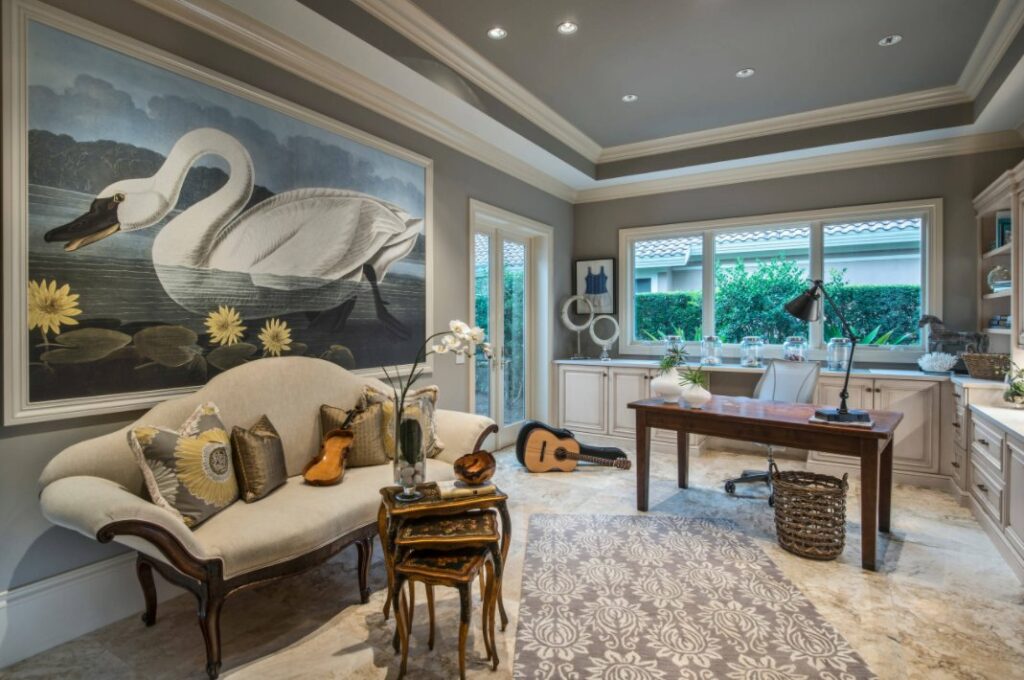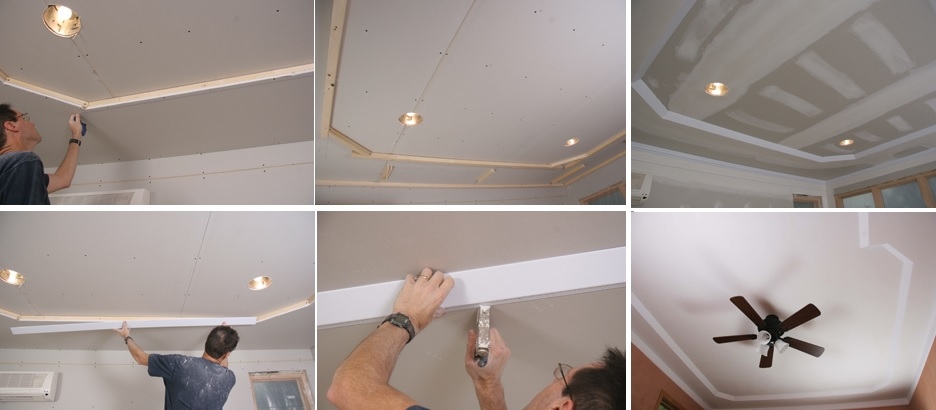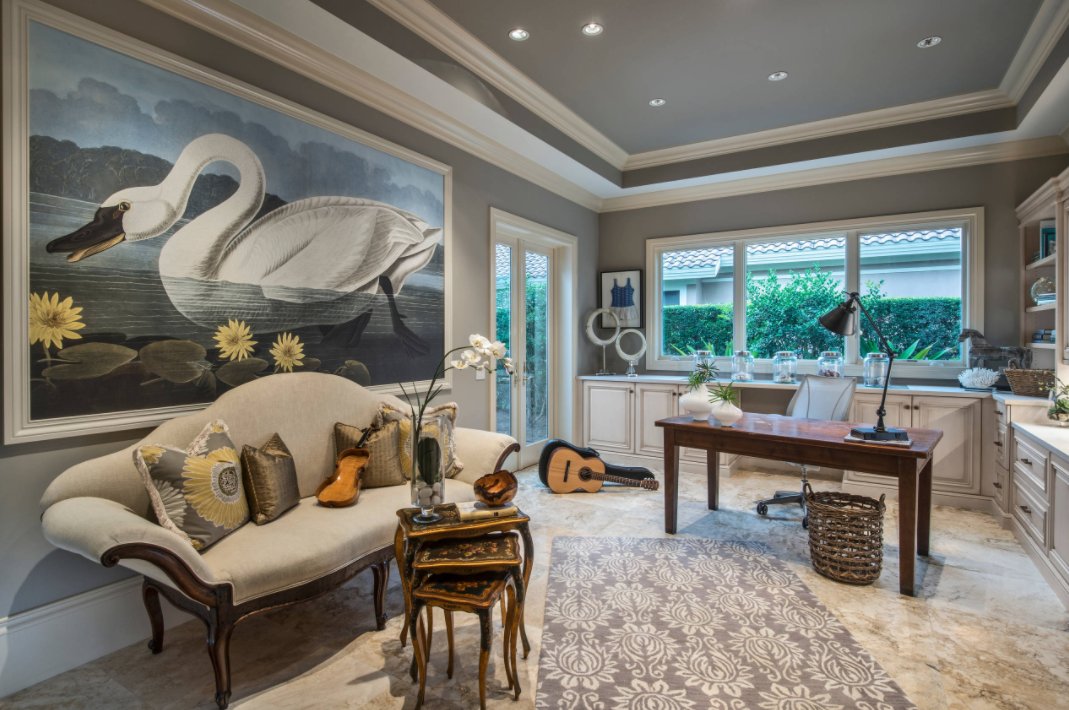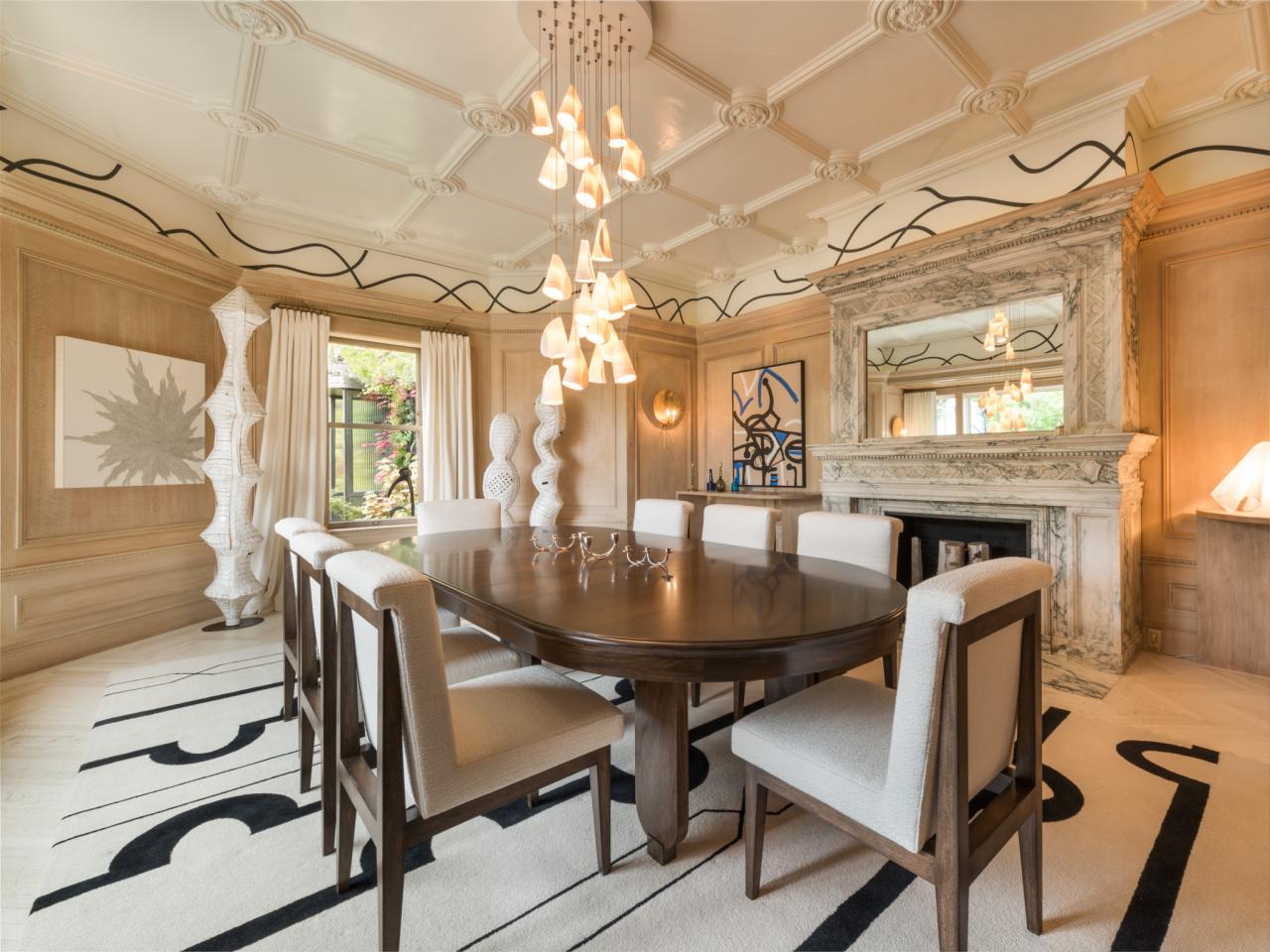Do you feel like you’re living in a box? Many homes can feel too squarish with their straight walls, straight floors and straight ceilings. You can paint and carpet all you like, but you’ll still have a flat surface above your head.
Lucky for you, there is a simple way to fix the whole view. Simply push into space above your ceiling and treat yourself to a tray ceiling. This will make any room, no matter the height, feel luxurious and elegant. But before you resign them to expensive homes, here are 19 reasons tray ceilings are for everyone, even you.
What Is a Tray Ceiling?
A tray ceiling, alternatively referred to as a recessed or inverted ceiling, resembles a giant upside-down tray embedded in the ceiling. The central part is several inches or feet higher compared to the edges, which draws the eye upward, adds visual interest, and gives the illusion of three-dimensionality.
A tray ceiling’s design is frequently dictated by the contour of the room and is achieved through the use of a drop-down border placed around the edges of the ceiling. The depth of the inside tray recession can be as small as one inch and as large as a foot, but the exact measurements depend on how high the ceiling is and what effect the homeowner is looking to achieve.
Because the majority of rooms are either rectangular or square, the majority of tray ceilings are as well, but there are no fast and hard design guidelines. Trays might be round, circular, or any other shape required.
What Is the Difference Between a Coffered Ceiling and a Tray Ceiling?
A close relative of the coffered ceiling, which has numerous recessed regions in a grid pattern, a tray ceiling has only one recessed area yet can be just as stunning as the coffered ceiling.
Although tray and coffered ceilings are frequently confused, there are numerous distinctions between the two. The distinctions range in price, how easy they are to install, and material composition, as well as the style possibilities available with either of the two options.
The distinction between a tray and coffered ceiling is that a coffered ceiling consists of sunken panels, whereas the other option resembles an upside-down tray. The people that do opt for coffered ceilings often do so because they aim to create an airy feel and may add value to your home. However, this comes at a price, since tray ceilings are cheaper compared to coffered ones.
Consider your priorities when determining which of these two types of ceilings is a better option for your home. If dramatic design is a priority and your budget is limited, coffered ceilings may be a better option. If you’re looking for a less expensive, more discreet approach to customize your ceiling, we recommend tray ceilings.
Most popular types of ceilings
We rarely think about this but there’s a variety of different types of ceilings. The conventional type that we’re all familiar with is just one of the options and perhaps the most versatile one of all. Others have distinctive features which are very helpful if you’re trying to put more emphasis on the ceiling itself and to make it an interesting part of the room’s décor or if you prefer a specific style.
1. Tray ceilings
A tray ceiling would normally have a sort of frame and they’re built upwards in a cutout. They visually resemble a tray, hence the name. The center of a tray ceiling is usually rectangular and either popped out or inverted which adds depth to the design. This style is useful if you want to make a small room appear taller or if you want to add a dramatic effect to the space through architectural features.
2. Cathedral ceilings
Speaking of architectural features, cathedral ceilings are very eye-catching and impressive. They’re also referred to as vaulted ceilings and have sloping sides that form an upside down V, meeting up towards the center at the highest point possible. These ceilings are typically very high and they make spaces look and feel elegant, airy and impressive.
Cathedral ceilings are also of different types, based on the shape of the scaffolding. The barrel cathedral ceiling for example has a single curved arch and is built under the rafters. The ceiling has two barrel vaults that intersect at 90 degree angles and form 4 convex ribs attached to the corners of the room.
A cloister ceiling has arches that rise from the middle of each wall as opposed to the corners and form concave ribs that curve inward. There’s also the domed ceiling which has a central spherical arch.
3. Coffered ceilings
You can easily recognize this type of ceiling by its waffle-like pattern. It forms a grid o sunken panels and molding and it has a classic, old-school look. In the past it was a sign of luxury as coffered ceilings were often made of carved stone or expensive wood
4. Suspended ceilings
You could call this a second ceiling below an existing one. It’s also known as a drop ceiling and it’s common in offices and other types of spaces where there’s usually a lot of wiring. It’s a sort of decorative ceiling which is flat and made of lightweight acoustic panels inside a grid. It lowers the original height of the ceiling and is very useful for hiding wiring and mechanical fixtures in order to get a clean look without any visible elements on it apart from the lighting.
5. Conventional ceilings
This is the type that we’re all familiar with. It’s most commonly found in regular homes and it’s the standard type of ceiling that fits with most types of spaces. It’s simple and has a flat surface which makes it very versatile and allows it to potentially be customized in a lot of different ways but also to be left as such in which case is doesn’t stand out at all.
How to customize and install your own ceiling
Beginners tray ceiling installation
If you’re up for a challenge, there are many different ways in which you can customize and decorate your own ceiling. For example, you could transform a conventional one into a tray ceiling if you think it would suit the room and enhance it in any way.
First, you will need to create the recess and the ceiling needs to have drywall attached before you start constructing the tray. Figure out what the width of the lowered area should be in relation to the overall size of the room and attach furring strips along this outline.
Next, attach drywall to the furring followed by the layering bead specifically designed for tray ceilings. Tape all the seams and the inside corners and use joint compound to hide the imperfections. You can then go ahead and paint your new ceiling. Check out this detailed tutorial on extremehowto for more info.
What You Need:
- Chalk line
- 2×4 lumber
- Furring strips
- Wood glue
- Screws
- ½ inch drywall
- EZ tray bead
- ceiling paint
Preparation Instructions
Step One: mark your lines
Using chalk lines, mark out the shape of your recess.
Step Two: Install the furring strips
Screw the furring strips along the lines you’ve marked, creating the shape of the recess.
Step Three: Drywall
Cut and attached the drywall to the outer shape. Drill into the furring strips.
Step Four: Trim
Using the EZ trim beading, trim the inside edges of the tray celling.
Step Five: Finish
Prime and paint using ceiling paint!
How To Chevron Plank Ceiling
You can also decorate an existing tray ceiling to make it even more interesting. A beautiful idea is to install planks into the center section and to create a beautiful chevron pattern with them. You can use plywood to reduce the cost of the project but other options are also available such as shiplap, tongue-and-groove planks and others.
Start by measuring the ceiling. Mark the center on each side and the corners and find the center point where they all meet.
Then figure out what the angles of the planks should be so they perfectly match and you don’t get any empty spots or misaligned planks. Then cut your plywood or planks and start to attach them to the ceiling in sections using adhesive and nails. At the end, paint everything. Check out queenbeeofhoneydos for more details.
What You Need:
- Wood planks or plywood
- wood glue
- brad nailer and nails
- paint
Preparation Instructions
Step One: Measure
Measure the ceiling area and the planking.
Step Two: Plan
Layout how and where you want the chevron planking to go.
Step Three: Cut
Cut all the planks to size.
Step Four: Install
Start installing each plank, one by one.
Step Five: Paint
Using the paint you chose, finish the planks with a few coats.
Stunning Wood Statement Ceiling
Based on whatever type of ceiling you have, you can come up with a design plan to decorate it and enhance its character.
A tray ceiling, as we’ve seen before, can be decorated with planks and a conventional ceiling can be transformed into an entirely different type. You can also use paint to highlight the existing design or add some molding, extra beams, built-in lighting and so on to create a statement ceiling. There are a few ideas on thelivedinlook that you might like.
What You Need:
- brad nailer and nails
- measuring tape
- wood glue
- Wood planks
- mitre saw
Preparation Instructions
Step One: Prep
Measure and plan the way you want to have the planks.
Step Two: Cut
Cut the planks to size using the mitre saw.
Step Three: Install
Using brad nails and wood glue, install the planks on the ceiling.
Step Four: Finish
Paint or stain the finished result.
Tray Ceilings Design ideas
This contemporary living room by Alan Mascord Design Associates has a beautiful tray ceiling with a very simplified design. The ceiling is also painted in the same colors as the walls and you’ll also notice that the back wall has a central ceiling that stands out. This establishes a visual connection with the ceiling and allows the central sections to have a slightly darker color that the rest.
Adding wood to the design of the ceiling is a great way of bringing warmth into a room. Tray ceilings are most common in areas like the kitchen or the dining room and, as you can see in this beautiful interior designed by studio MHK Architecture & Planning, a center decorated with wood planks looks exquisite.
Another idea is to use color to highlight the unique features and details of the ceiling as well as other elements in the room. This living room by studio Harwick Homes features white trims around the windows, doors, walls and ceiling which adds depth to the space and makes the simple and neutral color scheme appear less plain.
A great way to take advantage of a tray ceiling is by using color. This modern setting by Laura U Interior Design is so bright and cheerful and that’s partially thanks to the orange ceiling. The large windows let in lots of light and the ceiling emphasizes that effect. It also has multiple built-in light sources evenly distributed across the surface.
If you prefer your tray ceiling to have a simple monochromatic design you can still help it stand out by adding accent lighting to it. LED bands can be installed all along the inner edges which will highlight the design in a subtle but eye-catching manner. You can take inspiration from this stylish lounge area designed by studio Michael Abrams Interiors.
The aesthetic differences between the ceiling and the walls or the rest of the room can be very subtle but that wouldn’t necessarily make a tray ceiling any less interesting and beautiful. This one for example has accent lights installed along the outside and an interior decorated with wood. It’s not particularly striking but it definitely stands out.
Not only are tray ceilings good at separating the different areas of a large room, they are an easy way to add lighting where chandeliers or table lamps can’t reach. Just run the lighting around the edge and suddenly your room will be suspiciously brighter without a lot of light bulbs.
Are you looking to give your room some wow appeal? Think about warming up your tray ceiling with a bit of wood. Whether you install lighting or not, the comforting look will bring a welcoming feel to your space without having to change a single other thing.
Shiplap lovers, this one is for you. Putting a layer of shiplap into your tray ceiling will definitely amp up the farmhouse look of your room. Plus the texture is great for adding life and interest in an unexpected place.
While we’re talking about all the wood you can put into your tray ceiling, let’s think about some ornate trim pieces. Put a pattern on your ceiling and your dining room, or other space, will look like it belongs in the white house.
Contrary to some opinions, ceilings can be a great place for wallpaper, especially when it’s the textured kind. Just a little bit of color and your space will seem infused with your unique personality. Exactly the kind of feeling that makes your space seem like home.
Of course, feel free to put a pattern up there too. Especially in a room that is mostly neutral like a bathroom, that little extra something will give you a smile each time you enter the room. In fact, you might even want to add that element throughout your home too.
Many people are worried more about how others will view their home if they decide to sell when making their design decisions. If that describes you, put some neutral yet durable tile across your tray ceiling. The effect will feel expensive without emptying your pockets.
Does your home already possess tray ceilings that are deeper than usual? Make that count toward your design by painting them a color instead of the usual white. It will look charming and intentional instead of an eyesore.
Who says your tray ceilings have to be square? A round tray ceiling over a round dining room table will give your space the perfect look of beauty and symmetry, while showing off your real knowledge for interior design.
There is no reason why you should stick with one tray ceiling either. Go ahead and add the extra height with another layer or two. You won’t regret the gained headspace or the luxury look you’ll achieve.
FAQ
Is Tray Ceiling Modern?
Even if they have been around for hundreds of years, tray ceilings are still employed in modern residences.
Tray ceilings are often created using dimensional timber and then covered in drywall. For a clean, minimalist design, the drywall can be taped and completed without trim. You also have the option to add corner molding in case you want to conceal the seams.
A tray ceiling can be as plain or as ornate as desired to complement the room’s aesthetic. Crown molding is frequently used within tray borders to lend a touch of classic elegance. If you want to create a dramatic room look, you want the molding to be as large as possible.
Are Tray Ceilings Expensive?
Although the installation of a tray ceiling is best left to specialists, the process is surprisingly simple. Contractors typically add wood to the outer chamber to mimic the impression of a high tray. After installing the structure for the drop-down border, the wood is often coated with drywall.
Even if the costs for a tray ceiling can go all the way up to $1,500, home renovation website Kompare It claims it is far less expensive when placed during the construction of a home.
Do Tray Ceilings Add Value?
The woodwork required to construct a tray ceiling will also increase the value of your home. Tray ceilings may be both utilitarian and appealing. When a vent system is later added in older homes built before to the introduction of air and central heating systems, ducting is frequently routed on one side of the ceiling.
This results in the creation of a bulk header on just one side of the room. If the ceiling is sufficiently high, a tray ceiling can be erected to match the bulk header’s proportions, thereby concealing it within the tray ceiling design.
A tray ceiling can also conceal other mechanical parts, such as wiring or piping, within its drop-down border. This is an excellent choice for homes where routing such elements via the walls is not practical.
The post 19 Reasons Tray Ceilings Are Meant For You appeared first on Home Decorating Trends - Homedit.























0 Commentaires